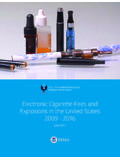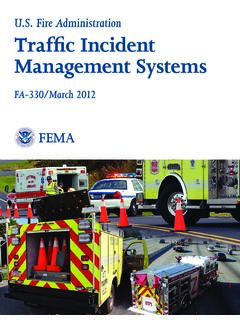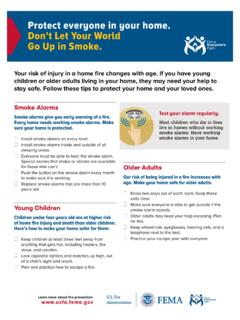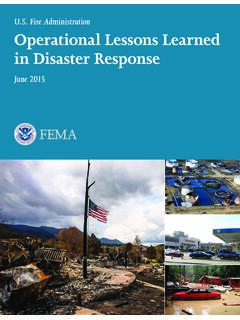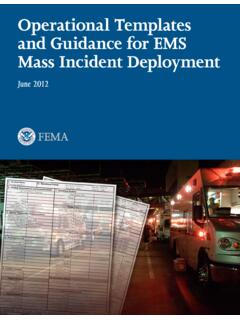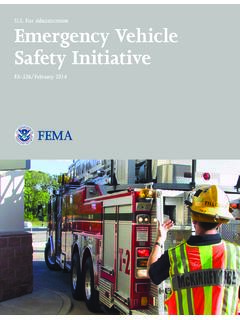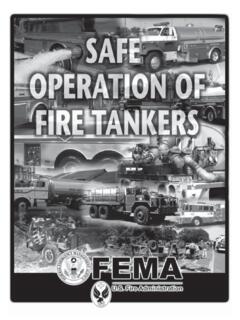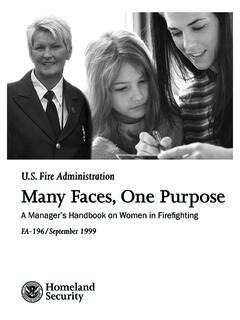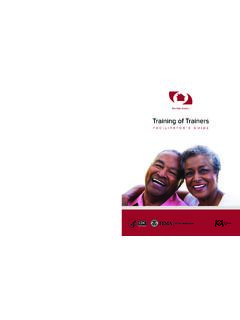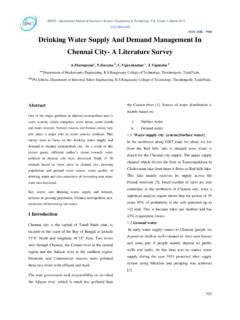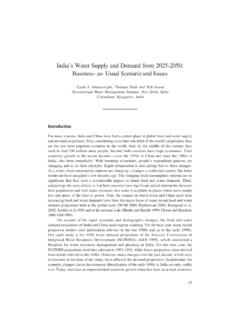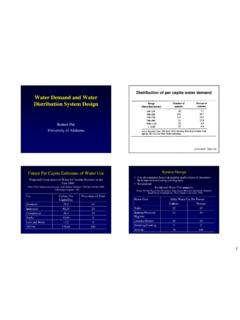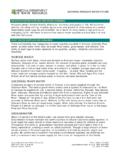Transcription of Water Supply Systems and Evaluation Methods: Volume I
1 Fire AdministrationWater Supply Systems and Evaluation MethodsVolume I: Water Supply System ConceptsOctober Fire AdministrationMission StatementWe provide National leadership to foster a solid foundation for local fire and emergency services for prevention, preparedness and Supply Systems and Evaluation Methods Volume I: Water Supply System Concepts Harry E. Hickey, project was performed by the Society of Fire Protection Engineers (SFPE) and was supported by the Department of Homeland Security s Science and Technology Directorate and the Fire Administration (USFA).
2 SFPE is an engineering association for advancing the science and practice of fire protection engineering. Water Supply is an important subject to the fire service, fire protection engineers, and city managers. These manuals are intended to provide a reference for concepts and terminology to facilitate communication and understanding between these the AuthorDr. Harry E. Hickey s career in fire protection spans more than 50 years. He taught Fire Protection Engineering at the University of Maryland for 26 years. He also has extensive experience in the fire services both as a firefighter, fire officer and Emergency Coordinator.
3 His combination of municipal fire administration and fire protection engineering experience provides him with unique insight into the challenges of design and operation of municipal Water supplies. He received his in Public Administration from American University in Washington, DC. He has authored many book and articles including Public Fire Safety, A Systems Approach, Fire Protection Hydraulics, and two editions of The Fire Suppression Rating Schedule Handbook. v Table of ContentsChapter 1: Fundamental Considerations Topic 1: Anatomy of a Water System.
4 6 Topic 2: Continuous Availability of Water Supply ..11 Topic 3: Municipal Water Supply Considerations ..13 Topic 4: Water Sources ..16 Topic 5: Classification of Water Systems ..19 Chapter 2: Processed Water for Domestic Consumption ..20 Topic 1: Unfiltered Surface Water Sources ..20 Topic 2: Filtered Surface Water Sources ..21 Topic 3: Water Treatment Plants ..23 Topic 4: Auxiliary Facilities for Surface Water Treatment ..28 Topic 5: Ground Subsurface Water Systems ..29 Chapter 3: Water Quality Standards ..32 A General Perspective on Water Quality.
5 32 Water Quality Monitoring ..39 Chapter 4: Water Distribution System Design Concepts ..51 Water Supply Source Classifications ..51 Water System Components ..52 Water System Classifications ..52 Composite Water Supply Systems ..56 System demand , Water Design and Flow Criteria ..57 Rates of Water Use ..58 Distribution System Hydrant Locations ..66 System Evaluation and Design ..71 vi Wa t e r Su p p l y Sy S t e mS Vo l. I: Sy S t e m Co nC e p tS ta b l e o f Co n t e n tS Basic Concepts in Determining Design Flow at System demand Points.
6 73 Distribution System Storage ..75 Elevated and Ground Storage ..77 Comparison of System Examples ..84 Recommended Practice on Water Storage ..84 Chapter 5: Consumer Consumption and Needed Fire Flow ..86 Water Demands ..86 A Suitable Approach for Studying Consumer Use Water demand ..91 Fire Suppression Water demand ..91 Special Notes on the Determination of Needed Fire Flows ..99 Chapter 6: Alternative Water Supplies ..101 Alternative Water Supply Concepts ..103 Where are Alternative Water Supplies Needed ..104 Water Supply Officer.
7 104 Identifying and Certifying Alternative Water Supplies ..105 Establishing an Alternative Water Delivery Program ..112 Chapter 7: Impacts of Fire Flow on Distribution System Water Quality, Design and Operation ..117 Background Statement ..117 Background ..118 Study Objectives and Scope ..118 Chapter 8: Dual Water Systems ..138 Basic Concepts ..138 Background Information ..139 Potential Applications for Dual Distribution Systems ..139 Sources of Nonpotable Water ..141 Potential Uses of Nonpotable Water ..141 Potential Uses for Nonpotable Water .
8 141 Nonpotable Water Reuse Legislation ..143 Reclaimed Water Quality and Treatment Requirements ..145 Reclaimed Water Monitoring Requirements ..146 Treatment Facility Reliability ..147 Groundwater Monitoring ..147 vii Wa t e r Su p p l y Sy S t e mS Vo l. I: Sy S t e m Co nC e p tS ta b l e o f Co n t e n tS Treatment for Reclaimed Water ..148 Reclamation Plants ..149 Storage ..150 Features of Reclaimed Water Distribution Systems ..151 The Future Role of Dual Water Systems ..152 Chapter 9: Water Supply and Effective Fire Protection.
9 153 Overview ..153 The Insurance Services Office, The Ability of Fire Departments to Provide Effective Fire Protection ..154 Fire Insurance Rates ..155 An Overview of Water Supply Under the ISO Fire Suppression Rating Schedule ..155 Insurance Company Assistance on Evaluating Water Supplies ..158 Advantages of Automatic Sprinkler Systems ..159 Water Supply Requirements for Sprinklered Properties ..161 Design Curves ..161 Hazard Classifications ..163 Residential Sprinkler Systems ..163 Types of Sprinklers for Commercial Buildings.
10 164 Pipe Schedule Systems ..164 Hydraulically Calculated Systems ..164 Standpipes ..165 The Physical Properties of Water ..168 Water Mist Fire Protection Systems ..171 Class A Foam Fire Protection ..174 Chapter 10: Separate Water Systems and Emergency Water Supplies ..178 Part I ..178 A Current Need for Individual Water Systems for Fire Protection ..180 Basic Design Concepts for Individual Water Supplies for Fire Protection ..181 Part II: Emergency Water Supplies ..184 1 W ater for human consumption comes from one of two basic sources: 1) Water from a well to Supply an individual residence, well Water for farmstead properties, and well Water for small public sector properties that include schools, public buildings, and small commercial ) Municipal Water Systems that provide potable Water to a wide array of commercial property and domestic use buildings including apartments, condominiums, duplex housing, and single family dwellings.
